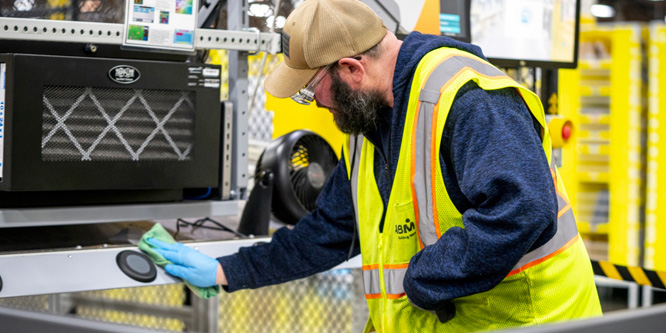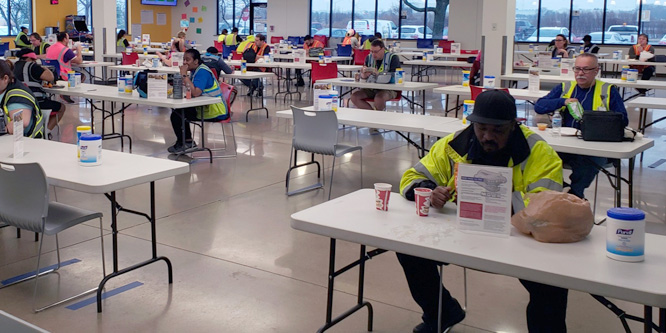
Photo: Amazon
Should working in retail warehouses be safer than stores?
Net-a-Porter and Next last week suspended online operations as the accelerated spread of the coronavirus places greater safety risks on its delivery and warehouse workers.
Net-a-Porter, the luxury e-retailer, said in an email to customers Friday, “We want to do everything we can to keep our colleagues, community and customers safe.”
Next, the U.K. fashion chain, said in a statement last Thursday, “Next has listened very carefully to its colleagues working in Warehousing and Distribution Operations to fulfil Online orders. It is clear that many increasingly feel they should be at home in the current climate.”
Among other retailers, Patagonia closed its stores and online operations on March 13. Rose Marcario, Patagonia’s CEO, said in a statement, “We are working to find solutions to protect the safety of our warehouse team, and we hope to have an update about online orders in the coming weeks.”
The closures come as most retailers aggressively push online orders to make up for temporarily shuttered locations.
Victoria’s Secret reopened its online website last Thursday that it had suspended on March 19. The lingerie giant’s site states, “We have been working around the clock to implement safeguards in our distribution centers and are pleased to say we feel confident in the steps we’ve taken.”
The retailer’s warehouse workers are now required to have their temperature taken before shifts and sit six feet apart at workstations, according to Business Insider. Management has added hand sanitizer stations and an onsite pharmacy to give workers easy access to “healthcare and medicines quickly and easily.”

Amazon.com has faced perhaps the harshest criticism over workplace safety during the pandemic. Reuters reported on Saturday that workers in at least 17 of the company’s 110 North American facilities had tested positive for COVID-19.
Steps Amazon is taking to enhance safety include increasing the frequency and intensity of cleaning as well as staggering shifts and break times to prevent crowding. Social media, however, is full of stories of Amazon workers sorting and packing closely together to keep up with the workload as online orders surge and supplies of hand sanitizer and wipes run low in warehouses.
- Net-A-Porter
- Temporary Closure of NEXT Online, Warehousing and Distribution – Next
- Next Employees Said The Company Is “Putting Lives At Risk” As Social Distancing Rules Aren’t Being Followed At Warehouses – Buzzfeed
- Net-a-Porter and Next are suspending online shopping to keep workers safe – CNN
- Patagonia
- Victoria’s Secret
- Victoria’s Secret reopens its online store but says that workers’ shifts in warehouses will be staggered and that they are now required to sit 6 feet apart – Business Insider
- How Amazon prioritizes health and safety while fulfilling customer orders – Amazon.com
- A message from our CEO and founder – Amazon.com
- Amazon Workers Are Scared, Unprotected As Coronavirus Sweeps Through Warehouses – Huffington Post
- ‘They’re putting us all at risk’: What it’s like working in Amazon’s warehouses during the coronavirus outbreak – CNBC
Discussion Questions
DISCUSSION QUESTIONS: What are the biggest hurdles to keeping distribution workers protected from the novel coronavirus? What solutions do you see?


Why would the standard be that one environment should be “safer” than another? Why not each environment is as safe as it can be made to be? One environment might be easier to make safe than another, but every employee deserves the best efforts in maintaining a reasonable level of “safe.”
This is a serious problem. Distribution is critical to the supply of essentials, but clearly this puts warehouse workers in peril. If there is a major disruption in distribution then product shortages will be exacerbated; shortages and panic buying will ensue.
Now that it seems that the supply shortage of personal protection equipment is becoming less acute, Amazon and other major distributors need to provide all of their warehouse/distribution employees with face masks, rubber gloves and other equipment to ensure they remain safe. Checking temperatures before every shift could also help avoid having sick workers handling packages. Distribution is on the front lines and retailers need to keep their critical workers safe.
This situation is still evolving and it takes time for new protocols to be standardized. The concerns will increase exponentially in next few weeks as the U.S. is still to hit peak.
It also shows that online businesses are not immune to this. The packaging, handling and shipping affects the workers, but also causes concerns for the consumers as they receive those packages.
Businesses have no option but to invest in the safety protocols, and pay hazard pay/bonus through these times. This also means many online-only businesses also will go out of business with these unplanned expenses. And they cannot pass to consumers because demand is too depressed. The headwinds are too strong and coming from just about every angle.
If it were up to me, I would assign a worker to every row (or a specific section) and put drop points at the end of each row for someone else to sweep and pick up, in order to deliver to sortation or consolidation. This requires a lot of rework in how waves are designed, and how orders get consolidated for pack and ship. But it’s the safest way to minimize contact inside the building.
Amazon is famous for not using any traditional wave methods that minimize worker travel – there are reports of people walking 10 miles or more during an 8-hour shift, all across giant warehouses, which is ridiculous and makes for easy spread of the virus if someone is sick and doesn’t know it.
Likewise, Amazon acquired Kiva Systems which would also minimize contact because it brings the items to sorters – provided the sorting stations are far enough apart. But that technology is no longer available to anyone else.
One last thing – Amazon is also famous for creating choke points out of their locations by requiring employees to go through metal detectors (and Amazon doesn’t have to pay for the wait time, which can be up to 45 minutes). I wonder how those are going right now?
Inherently, warehouse and distribution center workers are not safe now. Perhaps they are a little safer than store associates because they aren’t interacting with random customers all day long, but they still aren’t safe. I’d suggest hazard pay for those who want to work, extra PTO for those who don’t, and fulfilling orders for essential products first, as Amazon is doing.
Today, workers at Amazon’s distribution center on Staten Island are planning a walk-out to protest the lack of safety for warehouse workers, after a worker there tested positive for COVID-19. Amazon says they are doing everything that safety officials recommend. This is a serious dilemma.
Amazon and other distribution facility operators need to go above and beyond the minimum recommendations by health officials and adopt more aggressive measures.
“What are the biggest hurdles to keeping distribution workers protected from the novel coronavirus?” — Education. Multiple leading healthcare professionals across media channels are saying you can prevent transmission 99+ percent of the time by a combination of keeping your hands clean and, most importantly, avoiding touching your face. Period. Plain and simple. Install signs throughout each store for both staff and employees with the message on this sign. P.S., this sign was created during the H1N1 Swine Flu outbreak in 2009.
In a warehouse/distribution center environment it may be easier to maintain the same standard of “safe” as other facilities, such as a store where random customer engagement is a variable. However, this is still a difficult task and one that will require new processes, more time at the start of the day to sanitize the environment, added safety equipment for employees, and a change to existing operational processes to maintain social distancing conditions for employees. Employers should consider hazard pay, flexible hours for those who are concerned about coming to work, and added healthcare facilities where possible, and of course temperature checks to try and identify anyone at risk. Amazon seems to have received the lion’s share of attention in this regard, but they are by no means the only ones at risk. All online operations are at risk, and it is likely that we may see some pure plays unable to continue business operations due to the added costs and reduced revenues from lower demand. Particularly if the products they sell are not essential during this time. Luxury items may be the hardest hit.
A warehouse environment is more controllable than a store, mainly because you don’t have customers coming in and out. That said, there are still dangers and some workers, even with protections, are concerned and afraid. Retailers need to address that, perhaps by making working voluntary and/or rewarding employees better. Ulta has just put up wages by $2 an hour to recognize the efforts of their distribution center workers.
Warehouse workers already are under heavy pressure, have twice as many industrial accidents as any other private industry and work with just over minimal pay to optimize a cost center for most retailers. Working conditions are already rife with instances of abuse. There are inherently fewer people to engage with as tasks are repetitive and workers engage with product more than other people. A recent study from October 2019 shows the trend towards further automation and this will be the continuing trend. Just handing out sanitizer is not enough to make the workplace safer – especially when temp employees are added regularly and there is substantial turnover. Corrective actions can include safer hiring practices, safety protocol e.g., in-facility distancing and easing of conditions, focusing on demands for essential items like PPE first.
I guess the first question is “should ‘non-essential’ distributors/retailers even be open?” (It is its own topic, so I’ll leave that for another day.)
Presumably, the problems are the same as anywhere: inadvertent personal contact, or contact with contaminated surfaces, and the general issue of modifying for safety reasons work routines that were set up for efficiency reasons.